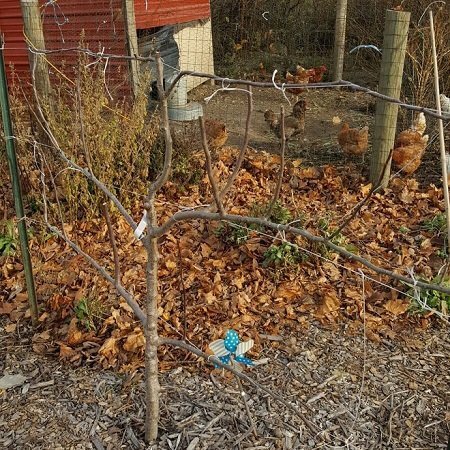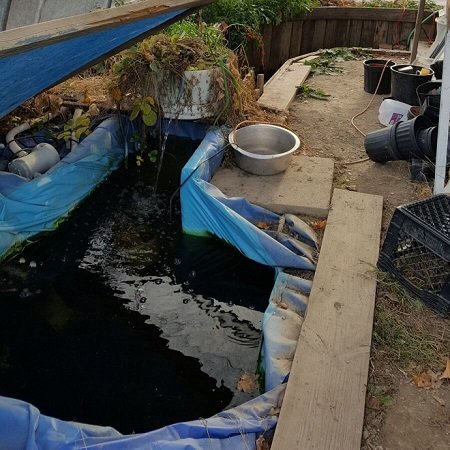
Rustic Homesteading with Limited Space
It’s really amazing what you can do on a small plot of land. I’m often surprised by what I can squeeze in on our ¾ acre plot. Whenever I think we’re maxed out, I seem to find a way to get one more plant or one more project in.
One way we saved space and produced more food on our small homestead was with espalier trees. Proof of this growing method has been identified in cave drawings dating back to at least the middle ages. This method of growing, called espalier, consists of growing trees or other plants on one plane, very similar to the way grapes are grown on trellises. Think of a Menorah candle holder. Not only is this a beautiful and unique way to grow fruit, but it’s extremely efficient.
Espaliering trees affords you the ability to produce more food in a smaller area. The fruit are healthier because of maximizing air flow. Picking the fruit is much easier and can be done by hand without a ladder. You will also be able to put espalier trees in small tight spots that a standard tree would never fit in. I make it a point to put in 2-3 fruit trees every year. You could never regret growing more fruit but will always regret not putting more in sooner.
A great and traditional way to use this method is by putting espalier trees against walls and fences. The heat of the sun warms the walls giving the fruit a head start in the spring. It also makes it easier to keep the trees from dying in the winter. I haven’t put any against my walls yet but I have strung some on wire supported by “T” posts. This has been working well for me and I’m trying to use them as borders along my walking paths.

The other benefit I gain by growing some of my fruit trees this way is that I get more growing space. I can plant other vegetables and flowers under the branches and still get almost full sun. When you have limited space, you need every edge you can get.
Another tool that is invaluable to our homestead is our hoop house. A hoop house is made from bent metal hoops covered with greenhouse plastic. This differs from a traditional green house because of the shape and the materials it’s made from. The hoop house is much more affordable to construct and quicker to build.
We felt that we really needed a hoop house to bring everything together. The first reason was to save money on buying plants. It’s so much cheaper to start your own plants, especially when you grow heirloom plants and save the seed like we do.
The second reason that we love our hoop house is because we can start plants earlier and grow later into the year. Some plants, like spinach and kale, can make it through the winter.
The third reason is that I can grow some plants that need warmer weather than my zone has. I don’t usually do this because fighting mother nature is typically useless, but I can make it work if the plant needs just a few degrees warmer than our zone.
The fourth reason having a hoop house is invaluable to us is that my whole family just loves to get sun in the winter! When the days are so cold our hoop house can easily reach 90 degrees Fahrenheit during the day. Having access to this heat in the winter will just put a smile on your face.
My hoop house is actually cut in half lengthwise. I did this for a few reasons. I didn’t need all the room of a full hoop house and it would take up more room than I would like to give up. If we built a narrower hoop house, the height would be shorter since it’s a hoop shape and not a “A” frame roof. So we bent 20 foot diameter hoops with just the one side making it 10 foot in diameter with the height we needed and mounted it to the side of our cinder block garage.
Mounting it to the garage gave it more strength and the heat of the day is absorbed by the cinder block wall that releases that heat back into the hoop house in the evening. It’s not going to make a huge difference during the night but it will add a few degrees of heat during the night.
I have a standard door in my garage that opens right to my hoop house. I can go from my house to my hoop house without ever going outside. It’s nice not having to walk through the snow and mud in bad weather. I usually just wear my slippers while drinking a cup of coffee in the dead of winter to start seeds. I also keep the door between the garage and hoop house open during winter days to warm my garage. If you use this design against your house with a window, then you could warm your house during the days with the heat of the sun.

I have a small 300-gallon aquaponics system in my hoop house. I made it from a $20.00 water pump and an old Intex pool liner. It’s over 2 years old and the fish are going strong. I put this aquaponics system in to help with moisture, grow fish to eat, and help retain more heat during the nights.
300 gallons isn’t enough to feed my family, but we can eat a few fish a year from the system. We plan to expand the system down a dug walkway in the hoop house which will allow 3,000 gallons for more fish.
Our aquaponics system is also a water catchment system. When it rains, our rain gutter spills to the fish tank. The overflow goes into my aquaponic grow bed, where I grow green onions in the winter and watercress in the summer. I also use the water to hydrate my hoop house beds. Using strips of cloth dangling in the water and dug under a few inches of soil helps water some areas.
The hoop house gets so hot that I use a shade cloth over the top to keep everything from overheating. This way it doesn’t get as hot. Not only is the hoop house for planting but you can butcher there in the winter, or store planting items or anything that won’t be ruined by heat or moisture.
Auxiliary heating systems can also be made to help heat the hoop house at night.
One of the most natural ways is by putting a pile of horse manure in one of the corners. It’s amazing how well this works! I did that last year and even though it did stink a little I didn’t get any frost for most of the winter. By spring I had a nice layer of compost to put on my beds. You will have to turn your pile whenever it cools off (to get it heated up again), but watch for overheating and fires.
Rocket mass heaters also work well for the hoop house. Using minimal wood to maximize the heat output is just about as sustainable as you can get. This type of heater is so efficient that no smoke comes from the chimney. All smoke is burned up by the super-heated process and the mass (usually made of a cob mixture) heats up and then gives it off gradually.
I don’t currently use a rocket mass heater because of the limited space I have. A heated compost pile will work just fine for my need. I am lucky enough to get all I need from less than a mile away. I have great Amish neighbors and it usually only costs me a ride to the local bank.












